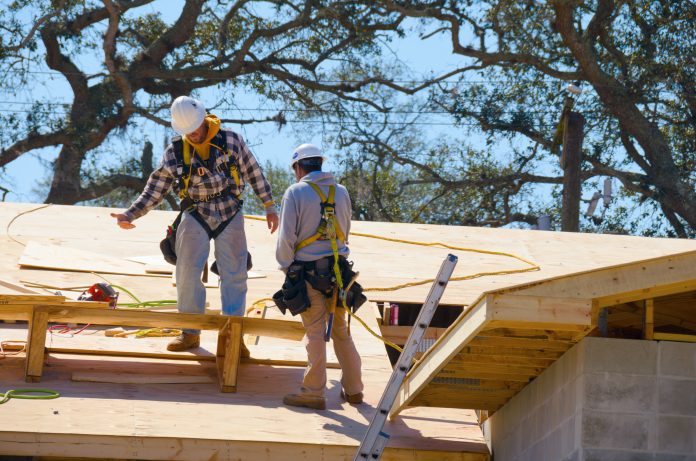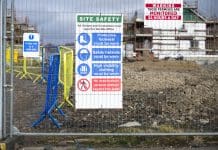Jonathan White, legal and compliance director at National Accident Helpline, explains how/when industry workers can claim compensation for construction site injuries, and how employers can avoid incidences in the first place
Falls from height are one of the biggest causes of workplace injuries and fatalities, with common causes including falls from ladders or through fragile roofs. A recent case saw two construction bosses being jailed for manslaughter by gross negligence after a roofer fell two storeys to his death in Hove. The company was also fined £190,000 and forced to pay £30,000 in costs after it was decided they failed in their duty of care to their employee.
The HSE found multiple safety failings, including no scaffolding or barriers to protect those working from height, while the ladder was only secured by two nails on either side of the timber frame on each side. The severity of the sentences demonstrated just how seriously employers are expected to take responsibility for the safety of their employees.
Follow the WAHR guidance:
As a result, there is comprehensive guidance laid out in the Work at Height Regulation 2005 (WAHR) to help prevent these incidences from occurring. If the appropriate precautions are not taken, an employer could be liable if a person falls and suffers personal injury.
Following the guidance in WAHR is normally enough to comply with the regulations, but the law also recognises there are low-risk situations where common sense might dictate no precautions are necessary. These rules apply if you are an employer or you control work at height, for example, if you are a contractor or a factory owner. The Regulations apply if someone is working on a ladder, a flat roof or where fragile surfaces are present but also where workers could fall into an opening in the floor or a hole in the ground.
Before working at height, employers must consider the following:
- Are you avoiding working at a height where it is reasonably practicable to do so?
- Where work at height cannot be avoided, can you prevent falls using either an existing place of work that is already safe or has the right type of equipment?
- Can you minimise the distance and consequences of a fall, by using the right type of equipment where the risk cannot be eliminated?
In practice, this means you must do as much work as possible from the ground, ensure workers at height can get safely to and from the height they are working, and that the equipment they are using is safe, suitable and regularly maintained. Employers must make sure those carrying out the work are not overloaded or overreaching, are taking extra precautions near fragile surfaces, have protection from falling objects and have a planned route of evacuation.
Ensure those supervising have appropriate training:
The key for employers looking to comply with the regulations is to make sure work is planned, supervised and carried out by competent people with the appropriate equipment. As training in these environments is often carried out on the job, it is essential that if someone is being trained, they are supervised by someone who is competent to do so. Despite the comprehensive regulations, exceptions are made for low-risk or short-duration tasks where common sense tells you no precautions are necessary. If someone is being trained in a low-risk situation, this may just involve them receiving instructions. If the work is more complex, such as assembling complex scaffolding, then employers may need to prove those supervising have had the appropriate training or industry certification schemes.
Factors to weigh up are the height of the task, the duration (less than 30 minutes) and frequency, as well as the condition of the surfaces. Employers can assess those risks here.
When would construction workers be due compensation for workplace injuries and how can they claim?
Construction workers can seek compensation for workplace injuries in a variety of situations. However, a certain criterion must be met before a claim can be made:
- The worker has been injured in a workplace accident – this could be anywhere where their activities are being controlled by someone else such as an employer or contractor.
- Someone else, for example, an employer, the main site contractor, or another sub-contractor, has been negligent or is at fault either in full or in part.
- This negligence has led to the construction worker being injured (There must be a link between the fault or negligence, and the accident).
- The employee is not solely to blame for the accident.
It is also possible to claim compensation when the injured person is partly at fault, for example, if they didn’t adhere to their training. Likewise, it’s important to note that regulations are often breached on construction sites, but claims are only valid if the breach causes the accident.
How do you determine if another person or business is at fault for an accident?
This is a very complex question, and the answer is highly fact specific. Legal advice is almost always required to determine if a claim is valid – particularly with construction claims.
Ultimately, this decision would be determined by a Judge assessing the facts and applying the law. There are dozens of regulations that are used as a reference point in determining whether a claim can be made. This would mean deducing if the regulations had been breached and whether, if they had been followed, the accident would have been avoided. If the judge finds this is the case, that is often sufficient to determine that a claim is valid, and that compensation is due. Breaching a regulation doesn’t usually create an automatic entitlement to compensation, but it is often very important in helping decide if an organisation is at fault.
Courts will also look at guidance, for example from the Health and Safety Executive (HSE) and hear from experts regarding good industry practice and whether this was followed, to help them assess whether someone was at fault.
Fault in construction sites is complex as there are often multiple organisations operating on the site, all with different responsibilities. Many construction workers are self-employed, which can give them greater responsibility for their own welfare but does not prevent them from claiming when other organisations have breached regulations.
In practice, most claims are negotiated directly between the injured persons’ solicitors and the responsible party’s insurers. Only about 2% of cases go to Court and more than 70% of claims commenced succeed.
What are the main regulations that if breached – can lead to a determination that compensation is due?
Below are the main regulations that if breached, can lead to a determination that compensation is due.
The Management of Health and Safety at Work Regulations 1999
Main employer duties under the Regulations include:
- making ‘assessments of risk’ to the health and safety of its workforce, and to act upon risks they identify, so as to reduce them (Regulation 3); appointing competent persons to oversee workplace health and safety; providing workers with information and training on occupational health and safety; and operating a written health and safety policy.
The Workplace (Health, Safety and Welfare) Regulations 1992
The main provisions of these Regulations require employers to provide:
- adequate lighting, heating, ventilation, and workspace (and keep them in a clean condition)
- safe passageways, i.e., to prevent slipping and tripping hazards
The Personal Protective Equipment at Work Regulations 1992
The main provisions require employers to:
- ensure that suitable personal protective equipment (PPE) is provided free of charge “wherever there are risks to health and safety that cannot be adequately controlled in other ways.” The PPE must be ‘suitable’ for the risk in question and include protective face masks and goggles, safety helmets, gloves, air filters, ear defenders, overalls and protective footwear
- provide information, training and instruction on the use of this equipment
The Manual Handling Operations Regulations 1992
The main provisions of these Regulations require employers to:
- avoid (so far as is reasonably practicable) the need for employees to undertake any manual handling activities involving the risk of injury
- make assessments of manual handling risks, and try to reduce the risk of injury. The assessment should consider the task, the load and the individual’s personal characteristics (physical strength, etc.)
- provide workers with information on the weight of each load
The Work at Height Regulations 2005
The main provisions of these regulations require employers to assess and manage risk when individuals they control are working at height (see specific details below)
The Construction (Design and Management) Regulations 2015
These regulations aim to improve health and safety in the construction industry by helping businesses:
- sensibly plan the work so the risks involved are managed from start to finish
- have the right people for the right job at the right time
- cooperate and coordinate your work with others
- have the right information about the risks and how they are being managed
- communicate this information effectively to those who need to know
- consult and engage with workers about the risks and how they are being managed
How can workers claim compensation?
Personal injury claims arising from accidents at work are often complex and legal advice is almost always necessary. Most law firms specialising in this area will undertake an initial assessment as to whether there is a claim, which is almost always done for free. This can usually be conducted via the telephone and takes roughly 30-45 minutes, depending on the complexity and severity of injuries.
If there is a claim worth pursuing, most law firms will offer to support the claim on a no-win, no-fee basis.
Other routes to claiming compensation include contacting your trade union or using legal expense insurance that may be in place. These organisations will recommend a specialist lawyer.
A claim is usually initiated by a solicitor notifying the employer’s insurance company of the claim and logging it on an official claim portal. The employers then have 30 days to confirm whether they accept the claim. If they do, the solicitors will then take steps to value the claim, e.g., by obtaining medical reports. If the employers do not accept the claim, further negotiations and evidence gathering are usually required or the claim may be dropped if it’s unlikely to succeed (with no charge to the employee).
It is illegal to sack people for bringing a personal injury claim.














